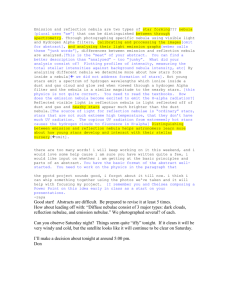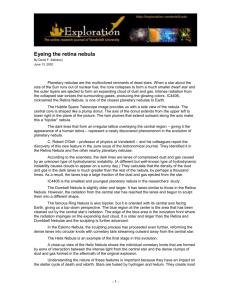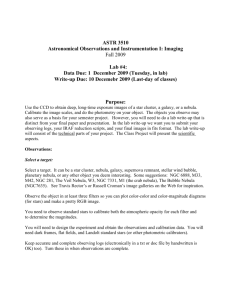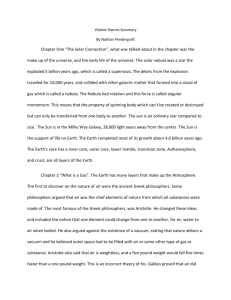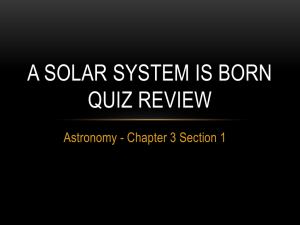Planetary Nebulae and Possible Proto
advertisement
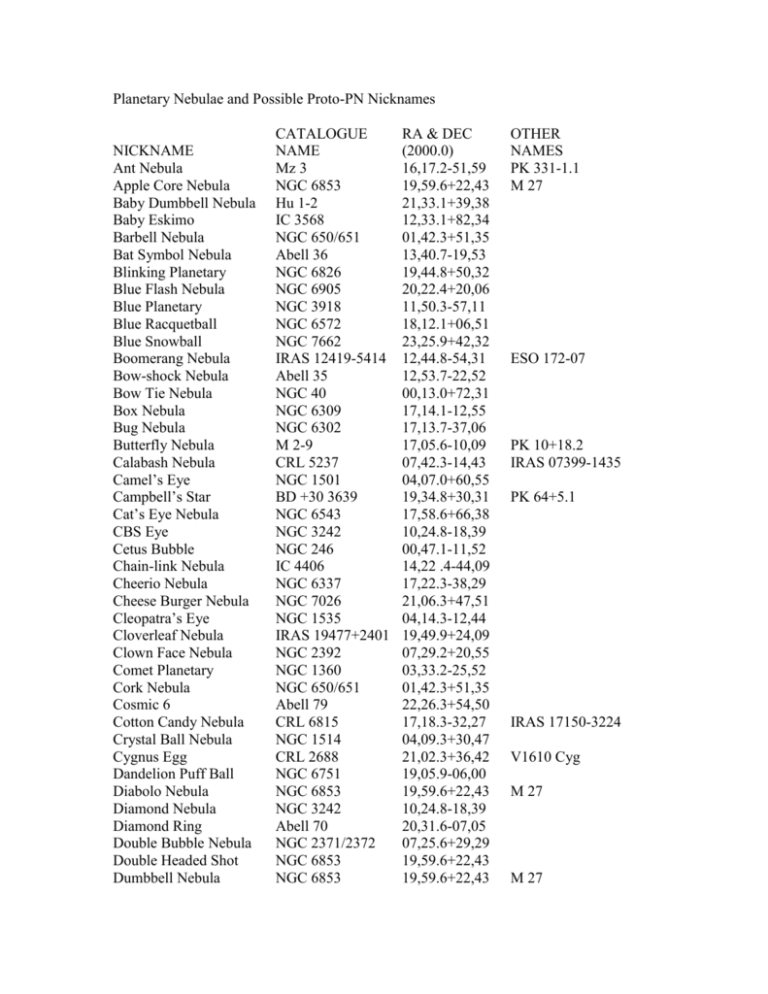
Planetary Nebulae and Possible Proto-PN Nicknames NICKNAME Ant Nebula Apple Core Nebula Baby Dumbbell Nebula Baby Eskimo Barbell Nebula Bat Symbol Nebula Blinking Planetary Blue Flash Nebula Blue Planetary Blue Racquetball Blue Snowball Boomerang Nebula Bow-shock Nebula Bow Tie Nebula Box Nebula Bug Nebula Butterfly Nebula Calabash Nebula Camel’s Eye Campbell’s Star Cat’s Eye Nebula CBS Eye Cetus Bubble Chain-link Nebula Cheerio Nebula Cheese Burger Nebula Cleopatra’s Eye Cloverleaf Nebula Clown Face Nebula Comet Planetary Cork Nebula Cosmic 6 Cotton Candy Nebula Crystal Ball Nebula Cygnus Egg Dandelion Puff Ball Diabolo Nebula Diamond Nebula Diamond Ring Double Bubble Nebula Double Headed Shot Dumbbell Nebula CATALOGUE NAME Mz 3 NGC 6853 Hu 1-2 IC 3568 NGC 650/651 Abell 36 NGC 6826 NGC 6905 NGC 3918 NGC 6572 NGC 7662 IRAS 12419-5414 Abell 35 NGC 40 NGC 6309 NGC 6302 M 2-9 CRL 5237 NGC 1501 BD +30 3639 NGC 6543 NGC 3242 NGC 246 IC 4406 NGC 6337 NGC 7026 NGC 1535 IRAS 19477+2401 NGC 2392 NGC 1360 NGC 650/651 Abell 79 CRL 6815 NGC 1514 CRL 2688 NGC 6751 NGC 6853 NGC 3242 Abell 70 NGC 2371/2372 NGC 6853 NGC 6853 RA & DEC (2000.0) 16,17.2-51,59 19,59.6+22,43 21,33.1+39,38 12,33.1+82,34 01,42.3+51,35 13,40.7-19,53 19,44.8+50,32 20,22.4+20,06 11,50.3-57,11 18,12.1+06,51 23,25.9+42,32 12,44.8-54,31 12,53.7-22,52 00,13.0+72,31 17,14.1-12,55 17,13.7-37,06 17,05.6-10,09 07,42.3-14,43 04,07.0+60,55 19,34.8+30,31 17,58.6+66,38 10,24.8-18,39 00,47.1-11,52 14,22 .4-44,09 17,22.3-38,29 21,06.3+47,51 04,14.3-12,44 19,49.9+24,09 07,29.2+20,55 03,33.2-25,52 01,42.3+51,35 22,26.3+54,50 17,18.3-32,27 04,09.3+30,47 21,02.3+36,42 19,05.9-06,00 19,59.6+22,43 10,24.8-18,39 20,31.6-07,05 07,25.6+29,29 19,59.6+22,43 19,59.6+22,43 OTHER NAMES PK 331-1.1 M 27 ESO 172-07 PK 10+18.2 IRAS 07399-1435 PK 64+5.1 IRAS 17150-3224 V1610 Cyg M 27 M 27 Page 2 Egg Nebula Eight Burst Nebula Emerald Nebula Eskimo Nebula Etched Hourglass Nebula Fetus Nebula Footprint Nebula Frosty Leo Nebula Garden-sprinkler Nebula Ghost of Jupiter Ghost of Uranus Ghost-Ring Nebula Gomez’s Hamburger Green Rectangle Hammer Nebula Headphones Nebula Helical Nebula Helix Nebula Hourglass Nebula Hubble’s Double Bubble Jelly-Fish Nebula Keyhole Planetary Lemon Slice Nebula Little Dumbbell Nebula Little Gem Little Ghost Little Ring Nebula Magic Carpet Nebula Mandrill Nebula Manzana Nebula Mask Nebula Medusa Nebula Merrill’s Star Minkowski’s Butterfly Minkowski’s Footprint Moth Nebula Octopus Nebula Owl Nebula Oyster Nebula Patchicks Planetary Peanut Nebula Phantom Streak Raspberry Nebula Red Planetary CRL 2688 NGC 3132 NGC 6572 NGC 2392 My Cn 18 NGC 7008 M 1-92 IRAS 09371+1212 He 3-1475 NGC 3242 NGC 3918 IC 5148/5150 IRAS 18059-3211 NGC 7027 VBRC 5 JE 1 NGC 7293 NGC 7293 MyCn 18 Hb 5 KFR 1 MRSL 252 IC 3568 NGC 650/651 NGC 6818 NGC 6369 M 2-51 NGC 7027 He 2-111 NeVe 3-3 MRSL 252 Abell 21 M 1-67 M 2-9 M 1-92 Sh 1-89 ESO 215-04 NGC 3587 NGC 1501 IRAS 19450+2922 CW Leo NGC 6741 IC 418 IC 418 21,02.3+36,42 10,07.0-40,26 18,12.1+06,51 07,29.2+20,55 13,39.6-67,23 21,00.5+54,33 19,36.3+29,33 09,39.9+11,59 17,45.2-17,57 10,24.8-18,39 11,50.3-57,11 21,59.6–39 23 18,09.2-32,10 21,07.0+42,14 13,44.0-60,50 07,57.8+53,25 22,29.6-20,50 22,29.6-20,50 13,39.6-67,23 17,47.9-30,00 12,00.2-59,05 15,09.4-55,34 12,33.1+82,34 01,42.3+51,35 19,44.0-14,09 17,29.3-23,46 22,16.1+57,29 21,07.0+42,14 14,33.3-60,50 08,03.2-33,31 15,09.4-55,34 07,29.0+13,15 19,11.5+16,52 17,05.6-10,09 19,36.3+29,33 21,14.1+47,46 10,54.7-48,47 11,14.8+55,01 04,07.0+60,55 19,47.1+29,30 09,47.9+13,17 19,02.6-00,27 05,27.5-12,42 05,27.5-12,42 V1610 Cyg PK 307-04.1 IRAS 19343+2926 IRAS 17423-1755 PN G309.2+01.3 PK 164+31.1 PK 307-4.1 PN G 359.3-00.9 PN G296.3+03.1 PN G321.6+02.2 M 76 PN G 315.0-00.3 PN G 250.4-01.3 PN G 321.6+02.2 PK 205+14.1 PK 050+03.1 PK 10+18.1 Drilling 1 M 97 IRC +10216 Page 3 Red Rectangle Red Spider Nebula Retina Nebula Ring Nebula Roberts 22 Rotten Egg Nebula Sakurai’s Object Saturn Nebula Scarab Nebula Seahorse Nebula Shapley’s Ring Shark’s Jaws Nebula Siamese Squid Silkworm Nebula Skull Nebula Snowglobe Nebula Southern Crab Southern Owl Nebula Southern Ring Nebula Spare Tyre Nebula Spindle Nebula Spiral Planetary Spirograph Nebula Stingray Nebula Sunflower Nebula Thackeray’s Planetary The Chamber of Horrors Tiny Dumbbell Nebula Turquoise Orb Turtle Nebula Twin Jet Nebula Walnut Nebula Water-Fountain Nebula Water Lily Nebula Westbrook Nebula White Eyed Pea Zodet’s Planetary CRL 915 NGC 6537 IC 4406 NGC 6720 CRL 4140 CRL 5237 V 4334 Sgr NGC 7009 NGC 40 K 3-35 Sp 1 K 1-3 M 2-9 CRL 5385 NGC 246 NGC 6781 He 2-104 K 1-22 NGC 3132 IC 5148/5150 IRAS 17106-3046 NGC 5189 IC 418 He 3-1357 NGC 7293 IC 1266 Mz 3 NGC 7026 NGC 6572 NGC 6210 M 2-9 IRAS 17245-3951 IRAS 16342-3814 IRAS 16594-4656 CRL 618 IC 4593 ESO 135-04 06,20.0-10,39 18,05.2-19,51 14,22.6-44,09 18,53.6+33,02 10,21.6-58,06 07,42.3-14,43 17,52.5-17,41 21,04.2-11,22 00,13.0+72,31 19,27.7+21,30 15,51.7-51,32 16,23.3-31,45 17,05.6-10,09 17,47.2-24,13 00,47.1-11,52 19,18.5+06,32 14,11.9-51,26 11,26.7-34,22 10,07.0-40,26 21,59.6-39,23 17,13.9-30,50 13,33.5-65,68 05,27.5-12,42 17,16.4-59,29 22,29.6-20,50 17,45.6-46,05 16,17.2-51,59 21,06.3+47,51 18,12.1+06,51 16,44.5+23,48 17,05.6-10,09 17,28.1-39,54 16,37.7-38,20 17,03.2-47,00 04,42.9+36,07 16,11.7+12,04 15,08.7-61,44 IRAS 06176-1036 M 57 IRAS 10197-5750 IRAS 07399-1435 PK 329+02.1 PK 346+12.1 PK 10+18.2 IRAS 17441-2411 PK 315+9.1 PK 283+25.1 IRAS 1719-5926 PK 331-1.1 PK 10+18.2 OH 344.07+5.84 IRAS 04395+3601 PK 318-3.1 Page 4 Below is the information where the nicknames came from and in some cases the actual origin of the nickname. I should have done this with the first versions of this nickname list. It would have made this job easier and more complete. The best description of the philosophy of planetary nicknames is at the beginning of Eric Honeycutt’s planetary nickname list, see http://www.icplanetaries.com/PNeNickname.htm . I could not agree more with Eric. I would like to thank David Frew for the many lists of nicknames and their origins, which he has sent me. Also I would like to thank Eric Honeycutt, Owen Brazell and Greg Crinklaw for their e-mails and help. If anyone has earlier references to these nicknames or origins of these nicknames that I have not been able to find please let me know. Kent Wallace, Revision 2, September 23, 2004. kwwallace@thegrid.net “Ant Nebula”: could not find out who coined this name. The earliest reference I could find to this name is from Jay McNeil’s “The Most Commonly Sought After Planetary Nebulae (Known, Possible and Misclassified)” which I will refer to as the McNeil 450 list. Jay McNeil sent me this list in December of 1998, unfortunately the list doesn’t have a date on it for when it was created. This nickname became popular after the release of its Hubble image in February of 2001, see APOD (Astronomy Picture of the Day), February 5, 2001. I could not find any articles in SIMBAD or under Google using this nickname prior to the date of the release of this Hubble image. The popular Hubble image is a composite of a July 20, 1997 Hubble image by Bruce Balick and Vincent Icke and a June 30, 1998 Hubble image by Raghvendra Sahai and John Tauger. Perhaps the name was coined from one of these earlier images. In David S. Evans 1959 paper, Mz 3 is mentioned as having an ant-like form, see the nickname “The Chamber of Horrors”. “Apple Core Nebula”: someone sent me an e-mail with this nickname on it but unfortunately I lost the e-mail and can’t recall who sent it. A google search did have a bunch of results. From SEDS under Common Names For Messier Objects, http://www.seds.org/messier/m-names.html , it was noted that the “Apple Core Nebula” nickname was contributed by J. R. Freeman and its use is common in Southern California. “Baby Dumbbell Nebula”: was evidently coined by Jay McNeil in an observing list of planetary nebula he created for use at the Texas Star Party. Also see Owen Brazell’s article “Where is the Edge in PN Observing”, in the Deep-Sky Observer # 120, spring 200, the quarterly Journal of the Webb Society, on page 27. “Baby Eskimo”: was coined by Jay McNeil in his January 1999 Sky & Telescope article, “Little-Known Planetaries”, on page 126. Also it is in the McNeil 450 list. Page 5 “Barbell Nebula”: could not find out who coined this name. The earliest reference I could find was Tom Reiland’s article, “Observing Planetary Nebula”, see Astronomy, August 1977, page 45. “Bat Symbol Nebula”: was evidently coined by Jay McNeil in an observing list of planetaries he created for use at the Texas Star Party. Also see Owen Brazell’s article “Where is the Edge in PN Observing”, in the Deep-Sky Observer # 120, spring 2000, the Quarterly Journal of the Webb Society, on page 27. “Blinking Planetary”: was coined by JamesMullaney and Wallace McCall in the early 1960’s due to the blinking effect it exhibited (see Sky & Telescope, November 1990, page 562). “Blue Flash Nebula”: was coined by John H. Mallas in his article, “Visual Atlas of Planetary nebulae VI”, see the Review of Popular Astronomy, July/August 1963, page 25. “Blue Planetary”: was coined by John Herschel, see “Star Names, Their Lore and Meaning by Richard Hinkley Allen”. “Blue Racquetball”: I don’t know who coined this nickname but the only place I could find it was as the title of an article on NGC 6572 by Greg Crinklaw, see http://www.skyhound.com/sh/archive/jul/NGC_6572.html . “Blue Snowball”: was coined by Leland S. Copeland who described NGC 7662 as looking like a light blue snowball in his article, “An Amateur’s Tour of Planetary Nebulae”, see Sky & Telescope, February 1960, page 216. “Boomerang Nebula”: was coined by K. N. R. Taylor and S. M. Scarrott in their paper, “The Boomerang Nebula: A highly polarized bipolar”, see 1980MNRAS…193..321. “Bow-shock Nebula: was evidently coined by Jay McNeil in an observing list of planetary nebulae he created for the Texas Star Party. Also see is Owen Brazell’s article “Where is the Edge in PN Observing?” in The Deep-Sky Observer # 120, spring 2000, the Quarterly Journal of The Webb Society, on page 27. “Bow Tie Nebula”: could not find out who coined this nickname. It seems to be a recent creation by my google searches. “Box Nebula”: was coined by Ron Morales, due to its rectangular appearance, see Star & Sky, July 1979, page 53. Page 6 “Bug Nebula”: was coined by Edward E. Barnard who stated, “From its singular appearance, I have called it the Bug Nebula”, see Astronomische Nachrichten, Nr 4136, December 1906, page 123 and 124. “Butterfly Nebula”: the earliest reference to this nickname was a 1978 article by Y. Andrillat and J. P. Swings titled “The Butterfly Nebula M 2-9: Its Possible Relation to B[e] Stars and Proto-Planetaries”, see 1978IAUS…76..328. This nickname was used quite a bit for M 2-9 in the professional literature until the Hubble image came out. See APOD for October 21, 1997 for a ground based image. “Calabash Nebula”: was coined by Vincent Icke and Heather L. Preston due to its peculiar shape, see 1989A&A…211..409. “CBS Eye”: can’t determine who coined this nickname. It is mentioned at the SEDS site, http://www.seds.org/~spider/spider/Misc/n3242.html . It really does look like a CBS eye in my 20"”scope, especially when I was viewing it high in the sky from Wongan Hills, Western Australia, in early 2004. “Camel’s Eye”: the only reference to this nickname is Eric Honeycutt’s neat list of planetary nicknames at http://www.icplanetaries.com/PNeNickname.htm . “Campbell’s Star”: this is a shorter version of, “Campbell’s hydrogen envelope star”, which is referred to in 1935PASP…47..162. In 1893 William W. Campbell found a hydrogen envelope around the star BD +30 3639 thus leading to this name. Walter Scott Houston uses the name, “Campbell’s hydrogen envelope star” in his Deep-Sky Wonders column in the August 1969 issue of Sky & Telescope, page 128 and the name, “Campbell’s hydrogen star” in the July 1971 issue of Sky & Telescope, page 54. In the August 1980 issue of Sky & Telescope, page 172, it is further pared down to “Campbell’s star” in Walter Scott Houston’s Deep-Sky Wonders column. “Cat’s Eye Nebula”: could not find out who coined this name. The earliest reference to this name was by Tom Reiland in his article, “Observing Planetary Nebulae”, see Astronomy, August 1977, page 45. CBS Eye”: can’t determine who coined this nickname. It is mentioned at the SEDS site, http://www.seds.org/~spider/spider/Misc/n3242.html . It really does look like a CBS eye in my 20" scope, especially when I was viewing it high in the sky from Wongan Hills, Western Australia, in early 2004. “Cetus Bubble”: is from Gregg D. Thompson’s “The Australian Guide to Stargazing”, page 89. My copy is a second edition published in 2001. Page 7 “Chain-link Nebula”: was evidently coined by Jay McNeil from an observing list of planetary nebulae he created for the Texas Star Party. Also see Owen Brazell’s article, “Where is the Edge in PN Observing?” in The Deep-Sky Observer # 120, spring 2000, the Quarterly Journal of the Webb Society, on page 27. “Cheerio Nebula”: is from an article, “The Menard 400”, by Viv Menard, in Amateur Astronomy # 30, summer 2001, on page 56. “Cheese Burger Nebula”: was coined by Jay McNeil, see entertaining amastro e-mail of November 3, 1999. “Cleopatra’s Eye”: was evidently coined by Greg Crinklaw, even though he would wish to remain anonymous. See amastro e-mails of September 10 & 11, 2004. “Cloverleaf Nebula”: this name was coined by Kate Y. L. Su, Bruce J. Hrivnak and Sun Kowk in their 2001 article, “High resolution Imaging of Proto-Planetary Nebulae: The effects of Orientation”, see 2001ApJ…122..1525. “Clown face Nebula”: could not find out who coined the name. It is referenced in Burnham’s Celestial Handbook, page 941. The name is probably due to its photographic appearance. “Comet Planetary”: is from Gregg D. Thompson’s “The Australian Guide to Stargazing”, page 90. My copy is a second edition published in 2001. “Cork Nebula”: may have been coined by Leland S. Copeland who stated that M 76 was cork shaped in his “List of Planetary Nebulae for Common telescopes”, see The Telescope, September-October 1940, page 115. The earliest reference to this name was in Burnham’s Celestial Handbook, page 1402. “Cosmic 6”: coined by Eric Honeycutt, from personal e-mail from Eric Honeycutt to Kent Wallace, July 24, 2001. “Cotton Candy Nebula”: this name was coined by Sun Kwok and others after observing this object with the Hubble Space Telescope in March of 1997, see Sun Kwok’s book, Cosmic Butterflies, page 110. “Crystal Ball Nebula”: may have been coined by David Knisely. Bruce Jensen in his observations of 12/11/99 titled “Pease, Please!” stated that David Knisely described this nebula as forming a “crystal ball” around the central star. “Cygnus Egg”: is from Sky Catalogue 2000.0 Volume 2, page xlvi. Page 8 “Dandelion Puff Ball”: evidently was coined by Bruce Balick because the only mention that I could find of this nickname using a google search was at his planetary nebulae site at http://www.astro.washington.edu/balick/WFPC2/ and his Scientific American article. Also see the July 2004 Scientific American article, “The Extraordinary Deaths of Ordinary Stars” by Bruce Balick and Adam Frank, on page 55. “Diabolo Nebula”: is from Sky Catalogue 2000.0 Volume 2, page xlvi. “Diamond Nebula”: was coined by John H. Mallas in his article, “Visual Atlas of Planetary Nebulae III”, see the Review of Popular Astronomy, January/February 1963, page 20. “Diamond Ring”: Eric Honeycutt remembers Jay McNeil calling Abell 70 this, private email, Eric Honeycutt to Kent Wallace, July 24, 2001. This name is also used by Eric Honeycutt in his article, “The Best Abell Planetary Nebulae”, see Sky & Telescope, May 2002, page 101. “Double Bubble Nebula”: could not determine who coined this name. The first mention of this nickname I could find was an article by Alister Ling titled “The Double Bubble” in the January 1997 issue of Astronomy, page 71. “Double Headed Shot”: was coined by John Herschel, during sweep 266, in his catalogue of nebulae presented to the Royal Society in 1833. See amastro e-mail by Steve Gottlieb on February 11, 2000. This name is also mentioned by Admiral William H. Smith in the 1844 Bedford Catalogue, page 466. “Dumbbell Nebula”: was coined by John Herschel in his catalogue of nebulae presented to the Royal Society in 1833, see The Catalogue of Galactic Nebulae, page 14. Also see amastro e-mail by Steve Gottlieb on February 11, 2000. “Egg Nebula”: was coined by Mike Merrill in 1974, see Sky & Telescope, January 1975, page 21. “Eight Burst Nebula”: was coined by H. Shapley and J. S. Paraskevopoulos in “Photographs of Thirty Southern Nebula and Clusters”, Harvard reprint, No. 184, 1940; and Proc. Nat. Acad Sci., 26, 31, 1940. Concerning NGC 3132 they say: “A series of photographs of varying exposures would be necessary to bring out the intricate details…. It could well be named the “8-burst” planetary from the number of distinct arcs on the boundary of the main disk or shell”. I got this information from “A Photographic Survey of Bright Southern Planetary Nebula” by David S. Evans and A. D. Thackeray, 1950MNRAS.110..429. Also see The Telescope, May-June 1940, page 65. Page 9 “Emerald Nebula”: could not determine who coined this nickname. It is mentioned in Jay Freeman’s article “The Horsie, the Duckie and the Blue Rose Nebula or for a Nickel you get to Focus”, see http://observers.org/reports/2001.09.15.3.html. “Eskimo Nebula”: could not determine who coined the name. The earliest reference to this nickname that I could find was Wiliam Liller’s 1965 paper “Expansion of Planetary Nebulae, on page 31, see 1965PASP…77..25. The name probably derived from its photographic appearance, where it looks like a face surrounded by a parka. “Etched Hourglass Nebula”: the Hubble image of MyCn 18, which came out on January 16 1996, seems to be the origin of this nickname. The NASA press release mentioned an hourglass shape with an intricate pattern of “etchings” on its walls. This nickname shows up on professional papers under SIMBAD after the Hubble image release date. Another nickname which shows up in professional papers in the post Hubble image date is the “Engraved Hourglass Nebula” which wasn’t included in this list because it didn’t fit the column. The “Etched Hourglass Nebula” also shows up on the McNeil 450 list. “Fetus Nebula”: was coined by Eric Honeycutt due to its appearance in his 22” scope, see Amateur Astronomy # 30, summer 2001, page 19. “Footprint Nebula”: this name seems to be taken from Minkowski’s Footprint which was given to M 1-92 by George H. Herbig in his 1975 article, “The Spectrum and Structure of “Minkowski’s Footprint”: M 1-92”, see 1975ApJ…200..1. In most professional journals it seems that Minkowski’s Footprint is always used and you don’t see the Footprint Nebula used at all. In non-professional sources the Footprint Nebula shows up quite a bit. It seems to be a shortened version of Minkowski’s Footprint. “Frosty Leo Nebula”: was coined by T. Forveille, M. Morris, A. Omont and L. Likkel in 1987A&A…176..13, “IRAS 09371+1212: an icy evolved, mass-losing star with a unique IR spectrum” on page 16. “Garden-sprinkler Nebula”: was most likely coined by Angels Riera due to the two curved jets that show up on images of this proto-PN. At the European Space Agency site, see http://www.esa.int/esaCP/SEMXU5S1VED_FeatureWeek_2.html is a beautiful image of this object. Also see the September 2003 issue of Astronomy, page 30. “Ghost of Jupiter”: evidently was coined by William Tyler Olcott who stated, “It will be seen like a pale blue disk, like a ghost of jupiter”, in his book, In Starland with a ThreeInch telescope, published in 1909. “Ghost of Uranus”: provided by David Frew who states, “I’ve used this name for a few years now (since John Herschel described this as “very like Uranus, only half as large again and blue”)”. Page 10 “Ghost-Ring Nebula”: is a suggested name coined by Richard Jakiel, see Astronomy, September 1997, page 87. Actually I prefer the Spare Tyre Nebula used by the Australians due to the thickness of this ring. “Gomez’s Hamburger”: is named after its discoverer, Aauturo Gomez, and its shape. Gomez discovered it in May 1985, see Astronomy, June 1986, page 78. The Astronomy article noted that it was being unofficially dubbed the Hamburger Nebula at that time. The earliest reference to this name I could find is 1987ApJ…316..21, “IRAS 180593211: Optically Known as Gomez’s Hamburger”, which came out in May. Also there is a November 1987 Sky & Telescope article on this object titled, “Chewing on Gomez’s Hamburger”, page 462. There is a wonderful image of this object on APOD for August 7, 2002. “Green Rectangle”: was coined by Kent Wallace. I’ve called NGC 7027 that, due to its appearance in my 20” scope at high powers. I believe that Greg Crinklaw has also mentioned that it appears as a green rectangle on his Sky Hound site. “Hammer Nebula”: it appears that Thomas Rauch et al coined this nickname in their article “Survey of Large Planetary Nebula in Decay”, see the ASP Conf. Series 199, 341 (2000). This nickname was provided by David Frew. The ADS biblocode for this one is 2000apn..conf..341. It really does look like a claw hammer on the Aladin Previewer red plate. “Headphones Nebula”: was coined by David Knisely and Rick Johnson, see amastro email dated May 08, 2002 from David Knisely. Also see Owen Brazell’s article, Where is the Edge in PN Observing?” in The Deep-Sky Observer # 120, spring 2000, the Quarterly Journal of the Webb Society, on page 27. “Helical Nebula”: could not determine who coined the name but it was used in Simon Newcomb’s 1932 book, Astronomy for Everybody. “Helix Nebula”: could not determine who coined the name. The earliest reference to the name that could be found was Tom Reiland’s article, “Observing Planetary nebulae”, Astronomy, August 1977, page 45. “Hourglass Nebula”: evidently this nickname originated with the NASA press release titled “Hubble Finds an Hourglass Around a Dying Star” for the Hubble image of MyCn 18 released on January 16, 1996. Also see the APOD on January 18, 1996. “Hubble’s Double Bubble”: seems to have been coined by Bruce Balick, see APOD for January 19, 1998. Also See http://www.astro.washington.edu/balick/WFPC2/hb5.caption.html. Page 11 “Jelly-Fish Nebula”: it appears that Thomas Rauch et al coined this nickname in their article “Survey of Large Planetary Nebula in Decay” , see the ASP Conf. Series 199, 341 (2000). This nickname was provided by David Frew. The ADS biblocode for this article is 2000apn..conf..341. “Keyhole Planetary”: was provided by David Frew who states, “the nickname is my own”. “Lemon Slice Nebula”: couldn’t determine who coined this nickname. I got the nickname from “The Astronomical Society of the Pacific’s Planetary Nebulae Slide and Information Booklet” by James B. Kaler and Bruce Balick, page 9. I got this booklet with a set of PNe slides I bought in 1998. The nickname definitely comes from the appearance of IC 3568 in the Hubble image, see APOD of December 25, 1998. “Little Dumbbell Nebula”: could not determine who coined the name. The earliest reference is Leland S. Copeland’s article, “An Amateur’s Tour of Planetary Nebula”, see Sky & Telescope, February 1960, page 216. “Little Gem”: was coined by John H. Mallas in his article, “Visual Atlas of Planetary Nebula V, see the Review of Popular Astronomy, May/June 1963, page 31. The writers of Sky Catalogue 2000.0, Volume 2, misread a line in The Observers Handbook – 1984, page 162 and listed the Little Gem as NGC 6445 instead of NGC 6818. This error has propagated through other works and is still cropping up today. “Little Ghost”: was coined by John H. Mallas in his article, “Visual Atlas of Planetary Nebulae IV”, see the Review of Popular Astronomy, March/April 1963, page 23. “Little Ring Nebula”: evidently was coined by Jay McNeil in an observing list of planetary nebula he created for the Texas Star Party. Also see Owen Brazell’s article, Where is the Edge in PN Observing?” in the Deep Sky Observer # 120, spring 2000, the Quarterly Journal of the Webb Society, on page 27. “Magic Carpet Nebula”: was coined by Kent Wallace. Yes, I fess up to creating this nickname. I remember reading about the Hubble photo of NGC 7027 being described as a hot coal on a carpet and came up with this name. I even got it published as an article in The Astronews, volume 48, number 5, June 2000, published by the Hawaiian Astronomical Society. Actually I prefer the “Green Rectangle” for NGC 7027 because of its appearance in my 20” scope at high powers. “Mandrill Nebula”: don’t know who gave it this nickname but according to David Frew it comes from the IAU Symp. 155, 208 (1993). In J. Meaborn’s and J. R. Walsh’s 1998 paper “Echelle Observations of High Speed Motions in the Extreme Bi-polar Nebula He 2-111 (PK 351-01)”, figure 1b on page 278 does look like the face of a Mandrill baboon with its long nose, see 1989A&A…223..277. Page 12 “Manzana Nebula”: provided by David Frew. This name was coined in 2000PASP…112…542 due to its appearance. Manzana is Spanish for “the apple”. “Mask Nebula”: see http://www.iac.es/gabinete/inves/result/97/ir13_86.htm for the IAC (Instituto de Astrofisica de Canarias) naming of this PN due to its appearance in their image. It really does look like a mask. “Medusa Nebula”: was coined by V. A. Vorontzov-Velyaminov, see 1960, Astr. Circ., No. 211, p. 25. This is from “Observation and Classification of the Nebula YM 29” by Hugh M. Johnson and Robert H. Rubin, 1971 ApJ…163..151. “Merrill’s Star”: the central star of M 1-67 has this nickname due to a 1938 paper by Paul W. Merrill titled “A Wolf-Rayet Star With High Velocity”, see1938PASP,,,50..350. The APOD for November 9, 1998 has an interesting Hubble image of M 1-67. “Minkowski’s Butterfly”: the earliest reference I could find to this nickname is in the McNeil 450 which I received in December of 1998. I think it is a wonderful nickname since it gives credit to its founder yet retains the original “Butterfly” name. Minkowski’s Footprint”: seems to originated in George H. Herbig’s 1975 article, “The Spectrum and Structure of “Minkowski’s Footprint”: M 1-92”, see 1975ApJ…200..1. “Moth Nebula”: the only place I could find this nickname is Eric Honeycutt’s list of planetary Nebula nicknames at http://www.icplanetaries.com/PneNickname.htm . On the Aladin Previewer red plate Sh 1-89 is quite bipolar. “Octopus Nebula”: was coined by Jay McNeil in an observing list of planetary nebulae he created for the Texas Star Party. Also see Owen Brazell’s article, “Where is the Edge in PN Observing?” in The Deep-Sky Observer # 120, spring 2000, the Quarterly Journal of the Webb Society, on page 27. “Owl Nebula”: was coined by Lord Rosse, who, in 1848, noted a striking resemblance to the face of an owl. “Oyster Nebula”: someone sent me this one in an e-mail which I lost and I don’t remember who sent it. “Patchick’s Planetary”: this object is named after amateur astronomer Dana Patchick who found it while examining DSS images on his computer in October 2003. Dana e-mailed me asking if it was in any of the PNe catalogues. It turned out it wasn’t. I suggested that he post it to the amastro group and see if anyone knew what it was. Brian Skiff replied that it is probably linked with IRAS 19450+2922 and the IRAS “colors” suggest it is possibly a planetary nebula. On October 20th I headed out to Navaho Flats to give this new object a try with my 20” f/5.0 reflector and was really surprised that it popped right Page 13 out when an O-III filter was used. Dr. George Jacoby took a spectrum of this object in late March of 2004 and we are waiting to hear his decision on the nature of this object. If this is a PN it will be the first one discovered since Walter Gale’s discovery of IC 5148/5150 in 1894. Post note: in July of 2004 I received an e-mail from David Frew who took a spectrum of this object and confirmed it to be a nice high-excitation PN. Thus I’ve changed the nickname from “Patchick’s Object” to “Padchick’s Planetary”. “Peanut Nebula”: can not determine who coined this nickname. It probably originated in the article “IRC +10216: a peanut nebula” by T. Le Bertre, P. Magain and M. Remy, see 1989Msngr..55…25. Unfortunately ADS does not have the article which I found listed under SIMBAD. This object seems to be an AGB carbon star, which is too young to qualify as a proto-PN. “Phantom Streak”: was coined by John H. Mallas in his article, “Visual Atlas of Planetary Nebulae V”, see the Review of Popular Astronomy, May/June 1963, page 31. “Raspberry Nebula”: is from an article, “The Menard 400”, by Vic Menard, in Amateur Astronomy # 30, summer 2001, on page 52. “Red Planetary”: provided by David Frew who states, “popular name down here in Australia, used more than the Raspberry Nebula though I like that name!”. “Red Rectangle”: it appears this name originated in 1975ApJ…196..179, “The Peculiar Object HD 44179 (“The Red Rectangle”)” by Martin Cohen, et al. “Red Spider Nebula”: could not determine who coined this nickname. It seems to have originated with the release of the Hubble image on September 12, 1997, see APOD of January 6, 1998. I suspect that the nickname was coined by Bruce Balick, Vincent Icke and Garrelt Mellema, the astronomers who had the Hubble image of NGC 6537 taken. “Retina Nebula”: evidently this nickname is from the release of the Hubble Heritage image of IC 4406 on June 13, 2002 where they dubbed it the “Retina Nebula” because the intricate tendrils of dust resemble the eye’s retina. Also see the July 2004 Scientific American article, “The Extraordinary Deaths of Ordinary Stars”, by Bruce Balick and Adam Frank, on page 57. “Ring Nebula”: could not determine who coined the name but in early works it is referred to as an annular nebula. “Roberts 22”: comes from its entry as object number 22 in M. S. Robert’s 1962 catalogue of Wolf-Rayet stars. Page 14 “Rotten Egg Nebula”: could not determine who coined this nickname. It probably originated with the release of the Hubble image of this object on October 19, 1999. Evidently it was dubbed the “Rotten Egg Nebula” because it contains unusually high amounts of sulfur, see APOD for November 1, 1999. I prefer the nickname “Calabash Nebula” for this object because it has been around a lot longer and is descriptive of its entire shape. “Sakurai’s Object”: is named after Yukio Sakurai who photographically discovered this object as a new star. At first it was thought to be a nova but now it looks like this object may have brightened because of a helium flash. It appears that this object may be at the final stage of an AGB star before becoming a proto-PNe. See Sky & Telescope, May 1996, page 11 and February 1999, page 24 for more details. “Saturn Nebula”: was coined by Lord Rosse because of the ansae that extend out either side. “Scarab Nebula”: I believe that Jay McNeil coined this name. It was used on an image of NGC 40 that Jay took. It does kind of look like a scarab beetle in his image. “Seahorse Nebula”: was coined by Orla B. Aaquist due to its radio image. See “The Mystery of K 3-35”, 1998JRASC..92…52, where Aaquist discusses the nickname. It is a funny article. Also see Sun Kwoks “Cosmic Butterflies” page 130. “Shapley’s Ring”: provided by David Frew who first heard this name used in the 90’s. “Shark’s Jaws Nebula”: provided by David Frew who stated, “this nickname is mentioned by professional astronomers in their papers on this object”. I did find a web site, which is http://www.astrsp-mrs.fr/private/nebulae/k13.html and contains images of K 1-3. This site states that this double-shell planetary nebula displays a “shark-jaws” structure. “Siamese Squid”: according to Bruce Balick the Hubble image of m 2-9 was dubbed this nickname by visitors to the Morrison Planetarium in San Francisco, see http://www.astro.washington.edu/balick/WFPC2/m29.caption.html . “Silkworm Nebula”: was coined by Kate Y. L. Su, Kevin Volk, Sun Kwok and Bruce J. Hrivnak not only for its appearance but also for the scientific connotation that the two lobes are breaking free of their AGB envelope as butterflies emerging from Cacoons during their metamorphosis. See 1998ApJ…508..744, “Hubble Space telescope Imaging of IRAS 17441-2411: A Case Study of a Bipolar Nebula with a Circumstellar Disk”, page 746. Page 15 “Skull Nebula”: in the November 1996 issue of Astronomy, Page 77, Bill Iburg, mentions in his article “A Deep-Sky Romp Through Fall Skies” that sharp photos of NGC 246 reveal an eerie, human skull-like appearance. In an amastro e-mail of September 19, 2001, Jay Freeman mentions that this object is sometimes called “The Skull Nebula”. “Snowglobe Nebula”: was coined by Lew Grammer, see Planetary Nebulae yahoo group e-mail, October 4th 2001. “Southern Crab”: evidently originated with an article in the Journal of the British Astronomical Association by Hugo Schwarz, Colin Aspin and Julie Lutz called “A southern ‘Crab’”, 1998JBAA…99…51. Also see Southern Astronomy, March/April 1989, page 14. “Southern Owl Nebula”: was coined by Jay McNeil in his January 1999 Sky & Telescope article “Little-Known Planetaries”, on page 128. Also it is in the McNeil 450 list. “Southern Ring Nebula”: could not discover who coined this nickname. It seems to orignated from the press release of the Hubble image of NGC 3132 on November 5, 1998. In the press release it says of NGC 3132: known to amateur astronomers in the southern hemisphere as the “Eight-Burst” or “Southern Ring Nebula”. See APOD on November 10, 1998. I could find no mention of the “Southern Ring Nebula” before the release date. If any amateur astronomers are aware of the use of this nickname before the release date, please let me know. “Spare Tyre Nebula”: is from the July/August 1990 issue of Southern Astronomy, page 48. I don’t know who coined it but it is pretty descriptive of its visual appearance. “Spindle Nebula”: was coined by Sun Kwok, Bruce J. Hrivnak and Kate Y. L. Su based in its general appearance, see page 150 of 2000ApJ…544..149, “Discovery of a DiskCollimated Bipolar Outflow in the Proto-Planetary Nebula IRAS 17106-3046. There is a nice image of this object on page 113 of Sun Kwok’s Cosmic Butterflies book. “Spiral Planetary”: is from “Hartung’s Astronomical Objects for Southern Telescopes” by David Malin and David Frew, second edition, published in 1995, page 294. “Spirograph Nebula”: could not determine who coined this nickname. According to the APOD of September 7, 2000, this object was named for its resemblance to drawings from a cyclical drawing tool. “Stingray Nebula”: was coined by M. Bobrowski, K. C. Sahu, M. Parthasarathy and P. Garcia-Lario in the April 2, 1998 issue of Nature, 1998Natur.392..469. The nickname is due to its appearance in a Hubble image, see APOD of April 3, 1998. Page 16 “Sunflower Nebula”: could not determine who coined the name. The earliest reference to this name that could be found was in Sky & Telescope, October 1969, page 262, in Walter Scott Houston’s Deep-Sky Wonders. “Thackeray’s Planetary”: was provided by David Frew from a list of PNe nicknames he culled from various sources. This object was found to be a planetary nebula in A. D. Thackeray’s 1950 paper “Some Southern Stars Involved in Nebulosity”, see 1950MNRAS.110..524. This object is also listed in the CGPN (Catalogue of Galactic Planetary Nebula) as Tc 1, standing for Thackeray 1. “The Chamber of Horrors”: was coined by David S. Evans in his “Notes on Five Southern Gaseous Nebulae”, see 1959MNRAS.119..150. This nickname was evidently coined due to troubles with its complex spectra. Mz 3 is listed as Anon 16h 13m.5 –51 52’ in Evans’ article and he refers to it as a grisly creature. Referring to its image on two different plates Evans states that they complete the ant-like form, see figure 1 in this paper. I wonder if this is the origin of the “Ant Nebula” nickname or if it is an independent naming. This paper and object is also mentioned in the April 1985 issue of Sky & telescope, page 316, in the article “Old Star or New?”. This nickname was provided by David Frew. “Tiny Dumbbell Nebula”: was suggested by Tom Polaskis for NGC 7026, see Astronomy, September 1998, page 85. Actually I prefer Jay McNeil’s “Cheese Burger Nebula” since there are too many dumbbells to keep track of. “Turquoise Orb”: is from Gregg D. Thompson’s “The Australian Guide to Stargazing”, page 90. My copy is a second edition published in 2001. “Turtle Nebula”: was coined by Dr. Robert Rubin, a former visiting professor of astronomy at UCLA who now works for the NASA Ames Research Center. The Hubble image reminded Rubin of a turtle so it was named the “Turtle Nebula”, see the December 4, 1998 issue of the Daily Bruin. This name is also mentioned in the February 1999 issue of Astronomy, page 30 and the APOD for October 1998. “Twin Jet Nebula”: it seems that Bruce Balick may have coined this nickname based on its appearance in a Hubble image, see http://www.astro.washington.edu/balick/WFPC2/ . Also see the NASA press release of December 17, 1997 of the Hubble image. There is also an APOD for this Hubble image of M 2-9 on December 23, 1997. “Walnut Nebula”: was coined by Bruce J. Hrivnak, Sun Kwok and Kate Y. L. Su based on its general appearance, see 1999ApJ…524..849, “The Discovery of Two new Bipolar Proto-Planetary Nebulae: IRAS 16594-4656 and IRAS 17245-3951”, page 851. Page 17 “Water-Fountain Nebula”,: was coined by R. Sahai et al in 1999ApJ…514..115, “The “Water-Fountain Nebula” IRAS 16342-3814: Hubble Space telescope/ Very Large Array Study of Bipolar Proto-Planetary Nebulae”. “Water Lily Nebula”: was coined due to its morphology resembling a flower, see 1999ApJ…524..849, “The Discovery of two New Bipolar Proto-Planetary Nebulae: IRAS 16594-4656 and IRAS 17425-3951”, by Bruce J. Hrivnak, Sun Kwok and Kate Y. L. Su, page 851. “Westbrook Nebula”: was named after Walliam E. Westbrook who died on June 4, 1975, at age 26, while his paper on this object was in press, see 1975ApJ…202..407. “White-Eyed Pea”: was coined by John H. Mallas in his article, “Visual Atlas of Planetary Nebulae III”, see the Review of Popular Astronomy, January/February 1963, page 21. Mallas may have coined the name based on the appearance of his sketch, which shows a faint oval with a bright center. “Zodet’s Planetary”: provided by David Frew, from 1984 Msngr..38..42W, The Messenger, “ESO Photographer finds New Celestial Object / Zodet’s Planetary = ESO 135-PN4 = 15H05M-61.6DEC”. Deleted Objects: “Campbells Hydrogen Star”, BD 30 3639, 19,34.8+30,31. This name is redundant to Campbell’s Star, which seems to be the one in common use now. Besides it was a bit long to fit in column 1. An even longer name for this object was “Campbell’s Hydrogen Envelope Star” which was used very early on. “Crescent Nebula”, NGC 6445, 17,49.3-20,01. This name is already well known for NGC 6888, a Wolf-Rayet star and nebula in Cygnus. “Gomez’s Nebula”, IRAS 18059-3211, 18,09.2-32,10. This name came from Astronomy, June 1986, page 78, article titled “Gomez’ Nebula is Rare Find”. In the article it is written “Object Gomez, unofficially dubbed the “Hamburger Nebula”. These various possible nicknames are redundant to Gomez’s Hamburger, which is well known now.
